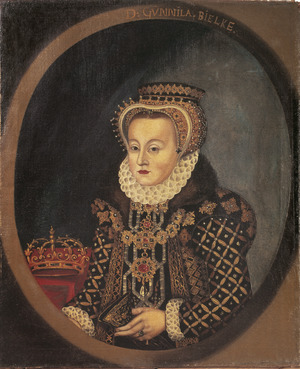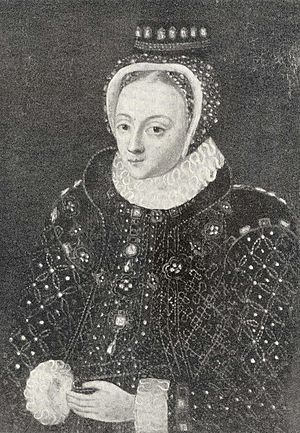Gunilla Bielke facts for kids
Quick facts for kids Gunilla Bielke |
|
|---|---|
 |
|
| Queen consort of Sweden | |
| Tenure | 15 February 1585– 17 November 1592 |
| Coronation | 22 February 1585 |
| Born | 25 June 1568 |
| Died | 19 July 1597 (aged 29) |
| Spouse | |
| Issue | John, Duke of Östergötland |
| Father | Johan Axelsson Bielke |
| Mother | Margareta Axelsdotter Posse |
Gunilla Bielke (born June 25, 1568 – died July 19, 1597) was a Swedish noblewoman who became the Queen of Sweden. She was the second wife of King John III. Many people believed Queen Gunilla was a trusted adviser to King John III. She also helped influence his decisions about religion, encouraging him to support Protestantism.
Contents
Becoming Queen: Gunilla Bielke's Story
Early Life and Royal Attention
Gunilla Bielke was the daughter of Johan Axelsson Bielke. Her father was a cousin of King John III. He was also a former governor of Östergötland. Her mother was Margareta Axelsdotter Posse. In 1582, Gunilla became a maid of honour to the Queen, Catherine Jagellon.
About six months after his first queen died in 1583, King John III decided to marry again. He chose Gunilla to be his next queen. People at the time described Gunilla as a beautiful blonde. The king himself said he wanted to marry her because of her beauty. He preferred to marry someone from his own country. He said he could see their true appearance, unlike portraits of foreign princesses.
A Controversial Marriage Choice
Just like the king's mother and stepmother, Gunilla was already engaged. She was promised to a nobleman named Per Jonsson Liljesparre. At first, she refused the king's proposal. Stories say the king was very angry about her refusal.
However, Gunilla's family made her agree to the marriage. Her engagement was broken off. Her wedding to the king was then arranged. This marriage was very controversial. The king's family did not approve of it. They thought it was a bad match because of the difference in their social rank.
Life as Queen: Influence and Challenges
Wedding and Coronation
The wedding ceremony took place in Västerås on February 21, 1585. Gunilla was crowned queen the very next day. Because of the controversy, the king wanted the event to be very grand. He planned many celebrations, including a tournament. Queen Gunilla gave out the prizes to the winners.
However, the king's brothers and sisters refused to attend the wedding. Only his sister Sophia, who lived in Sweden and needed his financial support, came. The king punished his other siblings by cutting their money. He also had a long conflict with his brother Charles. Queen Gunilla received a very large allowance. She is known as one of the richest queens of Sweden.
Queen Gunilla's Political Role
Queen Gunilla had a big influence on King John III. Many believe she helped him change his religious policies. She encouraged him to support Protestantism. This was different from his first wife, who had influenced him towards Catholicism. After he married Gunilla, his efforts to bring back Catholicism in Sweden mostly stopped. She often helped priests who were being treated unfairly for their beliefs.
In 1589, Gunilla went with John III to a meeting in Reval, Swedish Estonia. There, the king argued with his noble advisers. Gunilla acted as a peacemaker between the king and the advisers he had removed. In 1590, the king released the political prisoners, including her former guardian, at her request.
The king himself openly said that he changed his mind on many things "for the sake of our dear Queen's wishes." In the last years of John III's rule, many official papers were issued in the queen's name. This shows how much influence she had on state matters. She successfully helped people who asked for favors. Even the king's own siblings asked her to speak to him for them.
Criticism of Her Influence
Queen Gunilla's political influence was not always popular. Some people saw it in a negative way. This was because she was a member of the Swedish nobility. She was accused of using her power to help her own relatives. Her brother-in-law, Duke Charles, who later became King Charles IX, wrote negatively about her. He accused her of using her influence to benefit her family.
In 1590, John III wrote instructions for Queen Gunilla. He said she should rule as regent if their son became king while still a child. However, Gunilla and John III's son never became king. He was passed over first by his older half-brother, and then by his uncle.
Later, in the 1610s, King Gustav II Adolf wanted to marry a noblewoman named Ebba Brahe. His mother, Christina of Holstein-Gottorp, opposed this marriage. She used the marriage of John III and Gunilla Bielke as a bad example. She eventually stopped the marriage from happening.
Queen Dowager: After the King's Death
Protecting Her Inheritance
King John III died in 1592. According to one historical record, Queen Gunilla stayed by the king's side as he died. She held his hand and the hand of their son. John III was succeeded by his son from his first marriage, King Sigismund. Sigismund was Gunilla's stepson and was in Poland when his father died.
Queen Dowager Gunilla refused to leave the Royal Castle in Stockholm. She wanted to wait for Sigismund to arrive in Sweden. She hoped he would help her protect the large inheritance she received in her late husband's will. Her former brother-in-law, Duke Charles, was against her. Duke Charles claimed that Gunilla had hidden the king's death for days. He also accused her of stealing from the Royal Castle.
Clashes and Retirement
When Sigismund and his wife Anna of Austria arrived in Sweden in 1593, Gunilla asked for an inventory to clear her name. She also showed the late king's will to prove her claims were legal. Duke Charles argued that the property left to her was too large. He said the will should be declared illegal, even if it was truly the king's wish. Queen Anna also accused Gunilla of taking many things from the royal castle. She said it made the castle uncomfortable and empty. The two queens also disagreed on religious matters.
However, on May 18, 1594, King Sigismund confirmed Queen Dowager Gunilla's inheritance. She then moved to Bråborg Castle in her son's duchy, Östergötland. She lived there until her death. She received a very generous allowance and lands in her husband's will. She also had full custody of her son, and therefore control over his duchy.
Gunilla died from a fever on July 19, 1597. She was buried in Uppsala Cathedral.
Children
- John, Duke of Östergötland
Images for kids
See also
 In Spanish: Gunilla Johansdotter para niños
In Spanish: Gunilla Johansdotter para niños




